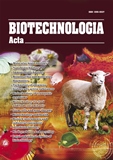ISSN 2410-7751 (Print)
ISSN 2410-776X (Online)

Biotechnologia Acta Т. 16, No. 3, 2023
P. 59-64 Bibliography 17, Engl.
UDC: 664.9; 639.21
DOI: https://doi.org/10.15407/biotech16.03.059
Full text: (PDF, in English)
DECOMPOSITION OF PHOSPHORUS-CONTAINING COMPOUNDS IN AQUEOUS AND POLYSACCHARIDE SOLUTIONS OF ORGANIC ACIDS
Malinovska I.M.
NSC "Institute of agriculture naan", Chabany, Kiev region, Ukraine
The purpose was to study the patterns of dissolution (solubilization) of phosphorus-containing minerals in aqueous and polysaccharide solutions of organic acids in order to model the mechanism of mineral destruction by soil bacteria synthesizing organic acids and exopolysaccharides.
Methods. Model, laboratory-analytical, microbiological, statistical.
Results. The destructive effect of organic acids on minerals is manifested both in aqueous and polysaccharide solutions. The introduction of bacterial polysaccharides into an aqueous solution of acids increases the decomposition of phosphorus-containing minerals by 1.34̶ 4.96 times. The influence of the chemical structure of acid molecules on the intensity of mineral decomposition is mainly manifested in the presence of bacterial polysaccharides, while in an aqueous solution, the effectiveness of acid action depends on the nature of the mineral being destroyed. To the maximum degree, polysaccharide increases the destruction of minerals in a solution of citric acid: molten magnesium phosphate ̶ 2.55 times, thermophosphate ̶ 2.11 times, phosphate flour ̶ 4.96 times. The decomposition of phosphorus compounds in solutions of ascorbic and oxalic acids enhances bacterial polysaccharides to a lesser extent than in citric acid solution.
Modeling the destruction of phosphorus-containing minerals under non-sterile conditions (soil conditions) made it possible to establish that organic acids under non-sterile conditions are subject to consumption by soil microbiota, especially ascorbic and citric acids, and to a lesser extent - succinic. Aqueous solutions of organic acids after 18 hours of incubation in non-sterile conditions lose their leaching activity by 1.06 ̶12.1 times. The introduction of a polysaccharide into aqueous solutions of acids makes it possible to avoid their rapid consumption by microorganisms, because of which the efficiency of mineral leaching under non-sterile conditions decreases by only 5–20% compared to sterile ones.
Conclusions. The introduction of a bacterial polysaccharide into a solution of organic acids enables the latter to be transferred to a sorbed state, as a result of which their susceptibility to consumption by microorganisms is sharply reduced. Thus, polysaccharide-forming bacteria not only destroy minerals more intensively than microorganisms synthesizing only low-molecular-weight metabolites but also synthesize a more stable and long-term functioning leaching complex in the soil.
Key words: phosphorus, bacteria, organic acid, polysaccharide, modeling, dissolution, mechanism.
© Palladin Institute of Biochemistry of the National Academy of Sciences of Ukraine, 2023
Refrences
1. Mogollón J.M., Beusen A.H.W, van GrinsvenH.J.M et al.. Future agricultural phosphorus demand according to the shared socioeconomic pathways. Glob Environ Change. 2018. 50.149–63. https://doi.org/10.1016/j.gloenvcha.2018.03.007
2. Аlori E.T., GlickB.R., Babalola O.O. Microbial phosphorus solubilization and its potential for use in sustainable agriculture. Front Microbiol. 2017. 8. 971. https://doi.org/10.3389/fmicb.2017.00971
3. Hsu C., Wu B., ChangY.et al. Phosphorylation of isoflavones by Bacillus subtilis BCRC 80517 may represent xenobiotic metabolism. J Agric Food Chem. 2018. 66.127–37.
4. GreinerR. Activity of Escherichia coli, Aspergillus niger and Rye phytase toward partially phosphorylated myo-inositol phosphates. J Agric Food Chem. 2017. 65:9603 – 7. https://doi.org/10.1021/acs.jafc.7b03897
5. Sharma S.B., SayyedR.Z., TrivediM.H. et al. Phosphate solubilizing microbes: sustainable approach for managing phosphorus deficiency in agricultural soils. Springer Plus. 2013. 2:1–14. https://doi.org/10.1186/2193-1801-2-587
6. Malinovska I.M. Agroecological bases of microbiological transformation of biogenic elements in the soil. Abstract doctor. dis. Kyiv. 2003. 34 P.
7. El-Gibaly M.H. et al.Studies on phosphate-solubilizing bacteria in soil and rhizosphere of different plants. Zbl.Bacteriol. Infect. 132. 3. 233. https://doi.org/10.1016/S0044-4057(77)80006-3
8. Agrochemical methods of soil research. M. М. Publishing House “Nauka”. 656.
9. Jones D.L., Darrah P.R. Role of root derived organic acids in the mobilization of nutrients from the rhizosphere. Plant and Soil. 1994. 166. 2. 234- 241. https://doi.org/10.1007/BF00008338
10. Waters C., Banks M.K., Schwab A.P. The effect of organic acids on leaching of zinc from mine tailings. Amer. Soc. Agron. Annu.Meet. 1992. Minneapolis. 1992. 63.
11. Linyan Yue,Weidong Kong,Chunge Li, Guibing Zhu, Liping Zhu, Thulani P Makhalanyane, Don A Cowan. Dissolved inorganic carbon determines the abundance of microbial primary producers and primary production in Tibetan Plateau lakes. FEMS Microbiology Ecology. 97. 2. 2021. https://doi.org/10.1093/femsec/fiaa242
12. Hue H.V. Effects of organic acids anions on P sorption and phytoavailability in soils with different mineralogies. Soil Sci. 1991. 152. 463-471. https://doi.org/10.1097/00010694-199112000-00009
13. Andreyuk E.I., Iutinskaya G.A., Izzheurova V.V., Kigel N.F., Ivanova N.I. Determination of growth parameters of soil microorganisms using bacterial exopolysaccharides. Microbiological journal. 1984. 46. 2. 83-84.
14. Zaikina N.A., Elinov N.P., Shataeva L.K., Domarad A.A. Activation and stabilization of proteolytic enzymes by microbial polysaccharides. Vopr.med. chem. 1970.16.14. 107-114.
15. Egorov N.S., Landau N.S. Biosynthesis of biologically active compounds by mixed cultures of microorganisms. Applied biochem. and microbio. 1982.18.6.44-52.
16. Egorov N.S., Landau N.S., Milovanova I.I. The nature and mechanism of action of the bioregulator formed by one of the components of the association of coryneform microorganisms. Report USSR Academy of Sciences. 1982. 4. 267-274.
17. Gogoleva E.V., Maksimov V.N., Grechushkina N.N., Egorov N.S. Optimization of the medium and the importance of some of its components for the biosynthesis of Mycobacterium lacticolum 121 exopolysaccharide. Microbiol. 1976. 45. 5. 765-774. https://doi.org/10.2307/43628183

